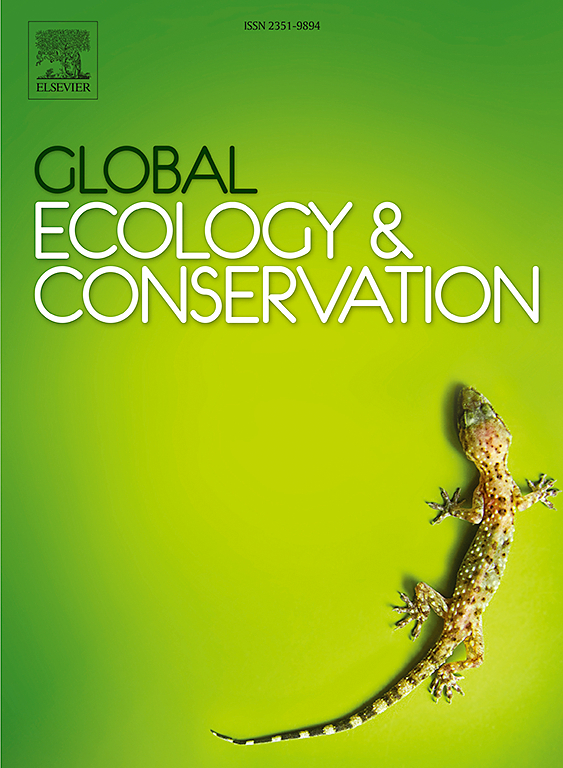孙德尔本斯地区老虎猎物及影响因素评估
IF 3.4
2区 环境科学与生态学
Q1 BIODIVERSITY CONSERVATION
引用次数: 0
摘要
监测猎物种类对老虎保护至关重要,特别是在猎物多样性有限的孙德尔本斯地区。本研究在统一的采样框架下,利用老虎斑纹和猎物颗粒数量,评估了老虎的猎物种类状况,并研究了老虎与猎物丰度的关系。在2021年至2023年期间,我们共建立了808个颗粒样地(每个样地200 m2),并进行了1286 km的船基样带收集数据。斑鹿(Axis Axis)和野猪(Sus scrofa)的平均颗粒群密度分别为295.09和27.21个/ha,密度分别为35.44和15.75个/km2。平均每公里河道中有0.47只虎斑,在东西森林区域有合理的变化,与最新的老虎密度估计值密切相关。广义线性模型显示,斑鹿与老虎丰度呈显著正相关,野猪与老虎丰度呈显著正相关,但无统计学意义。人为干扰和保护区对孙德尔本斯地区老虎数量有负面影响。本研究提出了一种具有成本效益的方法来监测老虎及其猎物,并为孙德尔本斯脆弱生态系统中的捕食者-猎物动态提供了有价值的见解。此外,我们的研究结果强调了斑鹿在维持老虎种群数量方面的关键作用,并强调了加强保护区和孙德尔本斯保护区保护战略的必要性。本文章由计算机程序翻译,如有差异,请以英文原文为准。
Assessing tiger prey and factors influencing tiger abundance in the Sundarbans
Monitoring prey species is crucial for tiger conservation, particularly in the Sundarbans, where prey diversity is limited. This study assessed the status of tiger prey species and examined the relationship between tiger and prey abundance using tiger pugmarks and prey pellet counts under a unified sampling framework. We established a total of 808 pellet sample plots (200 m2 each) and conducted 1286 km boat-based transect to collect data between 2021 and 2023. The mean pellet group densities of Spotted deer (Axis axis) and Wild boar (Sus scrofa) were 295.09 and 27.21 pellet groups/ha, corresponding to densities of 35.44 and 15.75 ind./km2, respectively. The mean number of tiger pugmark set was 0.47/km of river courses travelled, with reasonable variation across east-west forest regions that closely aligned with the latest tiger density estimates. The generalized linear model revealed a significant positive relationship between Spotted deer and tiger abundance, while the relationship between Wild boar and tiger abundance was positive but not statistically significant. In contrast, human disturbance and reserve forest had negative impacts on tiger abundance in the Sundarbans. This study presents a cost-effective method for monitoring tigers and their prey, and offers valuable insights into predator-prey dynamics within the fragile ecosystem of the Sundarbans. Furthermore, our findings underscore the critical role of Spotted deer in sustaining tiger populations and highlight the need to strengthen protection strategies not only for sanctuaries but also for the reserve forests of the Sundarbans.
求助全文
通过发布文献求助,成功后即可免费获取论文全文。
去求助
来源期刊

Global Ecology and Conservation
Agricultural and Biological Sciences-Ecology, Evolution, Behavior and Systematics
CiteScore
8.10
自引率
5.00%
发文量
346
审稿时长
83 days
期刊介绍:
Global Ecology and Conservation is a peer-reviewed, open-access journal covering all sub-disciplines of ecological and conservation science: from theory to practice, from molecules to ecosystems, from regional to global. The fields covered include: organismal, population, community, and ecosystem ecology; physiological, evolutionary, and behavioral ecology; and conservation science.
 求助内容:
求助内容: 应助结果提醒方式:
应助结果提醒方式:


